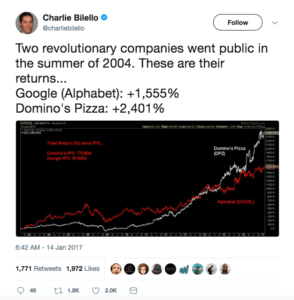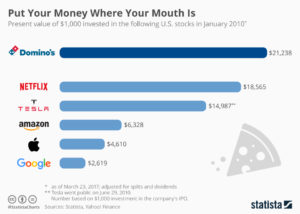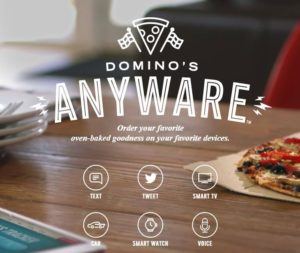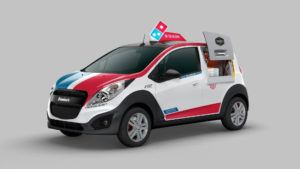“Put your Money where your Mouth is”

Why you should have, “put your money where your mouth is” and invested in the non-tech winner that is Domino’s Pizza instead of in all of the tech titans that we think of today.
Source: https://www.statista.com/chart/8670/dominos-stock-surges/
When we think of winners in tech most of else tend to think of the FAMAs of the world. What we don’t tend to think about are the greasy, late night, commoditised pizza delivery companies of the world. Yet, few who saw it can forget the tweet that circulated last year illustrating that Domino’s Pizza has significantly outperformed Alphabet, (by 846 percentage points), since their respective IPOs in the summer of 2004. Don’t believe me? See Charles Bilello’s, Director of Research at Pension Partners, tweet below:
How did a company that, at first glance, is inherently not related to tech, manage to utilise technology for such huge value creation for its shareholders? Sure, Domino’s is aided by the fact that pizza is not a fad food and unlikely to go out of style, but this also means that unlike Google, Domino’s is playing in a crowded market, where as Google is playing in a winner-take-all market, making Domino’s value capture even more impressive.
It was the management team’s dedicated focus to integrating a cohesive technology strategy across the company that has allowed it to be so successful. Domino’s focus has been on removing any barriers to purchase for consumers – just look at how a person can order from Domino’s today, via the mobile app, by tweeting at the company, or by texting an emoji of a pizza!
The Domino’s management team was cognizant of the fact that Domino’s is both a pizza manufacturing company and a pizza delivery company and that part of a positive consumer experience is receiving the pizza as soon as possible and to have it be piping hot. A great deal of innovation has gone into gamifying this process – with the Pizza Tracker giving the customer real time updates on her pizza and making her feel informed – as well as R&D developments that are in the works for the company. Examples of these are the Domino’s Robotic Unit, (DRU), an autonomous vehicle that would be able to deliver pizzas to customers’ homes without a driver, lowering costs for the company if the DRU can reach scale, adding an element of interest and excitement and meaning that delivery can happen 24/7. As well, Domino’s created a GPS Driver Tracker which allowed the company to ensure that their drivers were safe but also to gain insight and analytics into how the drivers were spending their time enabling management to create route improvements and efficiencies to increase the number of deliveries that each driver could make in a shift. Domino’s recognised that the transportation of the pizza was not only the key to a successful customer relationship, but also an excellent marketing moment, and so Doyle, the CEO, set up a crowd-sourcing campaign to create an auto design for the Domino’s delivery car, thereby building brand loyalty and consumer awareness as well as a tangible asset for the company – the design – in one crowd-sourced interaction. The car was especially innovative as it had only one seat in it and the rest of the space was filled with a warming oven that could hold up to 80 pizzas allowing the driver to deliver a much larger number of pizzas in one delivery run than before.
Russell Weiner, Chief Marketing Officer at Domino’s, made the company’s commitment to innovation and change very clear when he said in 2010 after the wildly successful launch of the company’s new pizza recipe, ““It’s quickly going to be no longer relevant to consumers what our pizza used to be,” he says. “But will there continue to be news and change from this brand? Absolutely. It’s how you stay relevant with consumers…There are more chapters in the story that we haven’t told yet”” Domino’s dedication to using technology to innovate and to stay at the forefront of its category has allowed the company to be a true winner in a space where most of its competing brands are falling behind and at risk of becoming irrelevant in the face of digital technologies.
Sources:
https://twitter.com/charliebilello/status/820279982387773440/photo/1
https://investorplace.com/2017/04/alphabet-inc-googl-getting-smoked-dominos-pizza-inc-dpz/view-all/#.WmaJDXeGPBJ
https://www.qsrmagazine.com/menu-innovations/many-acts-domino-s-pizza
https://www.dominos.com.au/inside-dominos/technology
https://www.statista.com/chart/8670/dominos-stock-surges/







While Domino truly embraced one of two key parts of its operating model – transportation, this success story probably would not happen without company changing its other part – pizza production, when Patrick Doyle joined as a new CEO in 2010. Company was open to criticism and learning and managed to dramatically improve pizza quality, while starting investing in technology.
Domino’s recent strategy is a great example of harmonious marriage of technology and quality through listening to its consumer.
Interesting topic. It is hard to allocate Domino’s success to its improved technology or its improved pizza quality, but it is great to see a CEO make changes to grow the business across multiple fronts. While Domino’s has taken a bet on self driving cars, their competitor Pizza Hut also announced a $130M investment in technology and advertising at the end of 2017. Their first announcement was a new pouch and delivery system that promised to deliver pizza 15 degrees hotter. It will be interesting to see how these competitors continue to create and claim value in the future.
Great topic, thanks for the post!
A thought: I wouldn’t have thought to say the dominos status tracker as very good nor their ordering workflow. I suppose this depends on what you compare to: tech products or other fast food products. Perhaps the bar is lower for such companies? Perhaps even more interestingly, the tech bar to satisfy consumers is actually lower than most of us think, (including me), and the real success is if you figure out what is truly important to your specific consumer.
Thanks!
Thanks, Eliza. I think what Domino’s has done is incredibly prescient, especially given they aren’t in the tech industry (it’s more less impressive when a tech company leverages technology to their advantage). I do wonder how they will continue to innovate – I’m not sure I see sustainable differentiation as every meaningful competitor has or will soon match everything Domino’s has accomplished (maybe Domino’s could put pizzas on drones…? Just kidding.). Clearly the market things it’s possible as DPZ trades at a rich valuation relative to competitors such as Papa John’s. I also worry about these pizza companies (such as Pizza Hut as Kat mentioned) pouring money into technology investments – these businesses are still only selling pizzas from $10-$15…it’s going to take a heck of a lot of pizza to recoup this nine figure investments.
Domino’s today reminds me a lot of Red Bull. They are a company selling a product that is relatively commoditized but have managed to differentiate themselves by investing in somewhat random and flashy endeavors to attract consumer attention. In fairness, most of Domino’s investments are much more clearly linked to their operating model (new ways of ordering and delivering) than Red Bull’s ( Red Bull Flugtag event or the Red Bull Air Race), but the impact is the same. Domino’s, as with Red Bull, seems cooler, edgier, and more fun than competitors delivery a similar product.
Interestingly, this approach has enabled Domino’s to perform incredibly well, allowing them to continue such investments. Today’s investments (such as the robotic delivery car) are not only attention-grabbing but will also contribute to improved performance, setting the company up for even more success. Red Bull’s events are still just a marketing tool.
I love this topic Eliza! This is an excellent example of how not all large incumbents are ‘destined to be disrupted’ by what a digital age entails. Fundamentally, if an organization focuses on correcting any friction to the service they are providing for their consumers there is little reason for mass number of consumers to jump ship. It also doesn’t leave ‘low hanging fruit’ on the table for startups, forcing startups to truly be differentiated and better than dominos to attract customers (unlike the Taxi industry in which any improvement in service would have stole away customers immediately). By lowering friction to Domino’s primary core competency, pizza, dominos has continued to guarantee itself a piece of the mind share of a pizza consumer when they are ready to order.